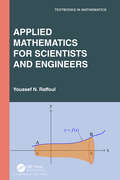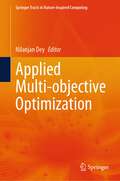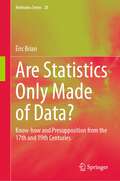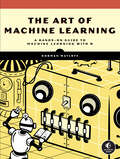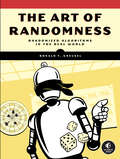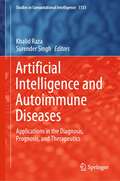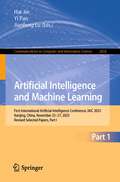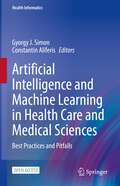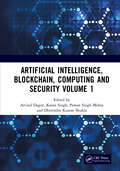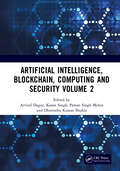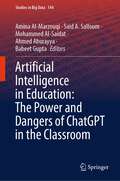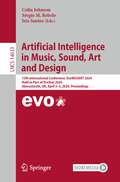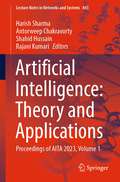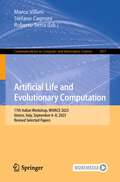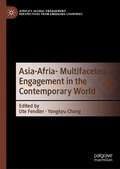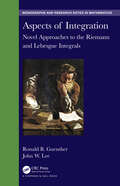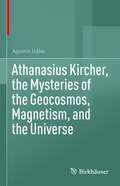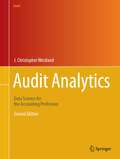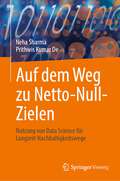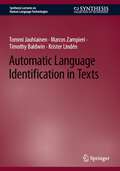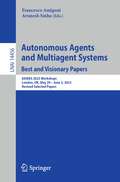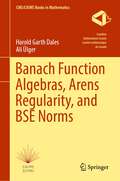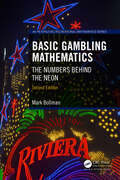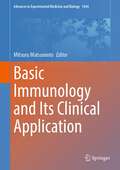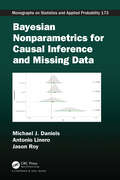- Table View
- List View
Applied Mathematics for Scientists and Engineers (Textbooks in Mathematics)
by Youssef N. RaffoulAfter many years of teaching graduate courses in applied mathematics, Youssef N. Raffoul saw a need among his students for a book reviewing topics from undergraduate courses to help them recall what they had learned, while his students urged him to publish a brief and approachable book on the topic. Thus, the author used his lecture notes from his graduate course in applied mathematical methods, which comprises three chapters on linear algebra, calculus of variations, and integral equations, to serve as the foundation for this work. These notes have undergone continuous revision. Applied Mathematics for Scientists and Engineers is designed to be used as a graduate textbook for one semester. The five chapters in the book can be used by the instructor to create a one-semester, three-chapter course. The only prerequisites for this self-contained book are a basic understanding of calculus and differential equations. In order to make the book accessible to a broad audience, the author endeavored to strike a balance between rigor and presentation of the most challenging content in a simple format by adopting friendlier, more approachable notations and using numerous examples to clarify complex themes. The hope is both instructors and students will find, in this single volume, a refresher on topics necessary to further their courses and study.
Applied Multi-objective Optimization (Springer Tracts in Nature-Inspired Computing)
by Nilanjan DeyThe book explains basic ideas behind several kinds of applied multi-objective optimization and shows how it will be applied in practical contexts in the domain of healthcare, engineering design, and manufacturing. The book discusses how meta-heuristic algorithms are successful in resolving challenging, multi-objective optimization issues in various disciplines, including engineering, economics, medical and environmental management. The topic is useful for graduates, researchers and lecturers in optimization, engineering, management science and computer science.
Are Statistics Only Made of Data?: Know-how and Presupposition from the 17th and 19th Centuries (Methodos Series #20)
by Éric BrianThis book examines several epistemological regimes in studies of numerical data over the last four centuries. It distinguishes these regimes and mobilises questions present in the philosophy of science, sociology and historical works throughout the 20th century. Attention is given to the skills of scholars and their methods, their assumptions, and the socio-historical conditions that made calculations and their interpretations possible. In doing so, questions posed as early as Émile Durkheim’s and Ernst Cassirer’s ones are revisited and the concept of symbolic form is put to the test in this particular survey, conducted over long period of time. Although distinct from a methodological and epistemological point of view, today these regimes may be found together in the toolbox of statisticians and those who comment on their conclusions. As such, the book is addressed to social scientists and historians and all those who are interested in numerical productions.
The Art of Machine Learning: A Hands-On Guide to Machine Learning with R
by Norman MatloffLearn to expertly apply a range of machine learning methods to real data with this practical guide.Packed with real datasets and practical examples, The Art of Machine Learning will help you develop an intuitive understanding of how and why ML methods work, without the need for advanced math.As you work through the book, you&’ll learn how to implement a range of powerful ML techniques, starting with the k-Nearest Neighbors (k-NN) method and random forests, and moving on to gradient boosting, support vector machines (SVMs), neural networks, and more.With the aid of real datasets, you&’ll delve into regression models through the use of a bike-sharing dataset, explore decision trees by leveraging New York City taxi data, and dissect parametric methods with baseball player stats. You&’ll also find expert tips for avoiding common problems, like handling &“dirty&” or unbalanced data, and how to troubleshoot pitfalls.You&’ll also explore:How to deal with large datasets and techniques for dimension reductionDetails on how the Bias-Variance Trade-off plays out in specific ML methodsModels based on linear relationships, including ridge and LASSO regressionReal-world image and text classification and how to handle time series dataMachine learning is an art that requires careful tuning and tweaking. With The Art of Machine Learning as your guide, you&’ll master the underlying principles of ML that will empower you to effectively use these models, rather than simply provide a few stock actions with limited practical use.Requirements: A basic understanding of graphs and charts and familiarity with the R programming language
The Art of Randomness: Randomized Algorithms in the Real World
by Ronald T. KneuselHarness the power of randomness (and Python code) to solve real-world problems in fun, hands-on experiments—from simulating evolution to encrypting messages to making machine-learning algorithms!The Art of Randomness is a hands-on guide to mastering the many ways you can use randomized algorithms to solve real programming and scientific problems. You&’ll learn how to use randomness to run simulations, hide information, design experiments, and even create art and music. All you need is some Python, basic high school math, and a roll of the dice.Author Ronald T. Kneusel focuses on helping you build your intuition so that you&’ll know when and how to use random processes to get things done. You&’ll develop a randomness engine (a Python class that supplies random values from your chosen source), then explore how to leverage randomness to:Simulate Darwinian evolution and optimize with swarm-based search algorithmsDesign scientific experiments to produce more meaningful results by making them truly randomImplement machine learning algorithms like neural networks and random forestsUse Markov Chain Monte Carlo methods to sample from complex distributionsHide information in audio files and images, generate art, and create musicReconstruct original signals and images from only randomly sampled dataScientific anecdotes and code examples throughout illustrate how randomness plays into areas like optimization, machine learning, and audio signals. End-of-chapter exercises encourage further exploration.Whether you&’re a programmer, scientist, engineer, mathematician, or artist, you&’ll find The Art of Randomness to be your ticket to discovering the hidden power of applied randomness and the ways it can transform your approach to solving problems, from the technical to the artistic.
Artificial Intelligence and Autoimmune Diseases: Applications in the Diagnosis, Prognosis, and Therapeutics (Studies in Computational Intelligence #1133)
by Khalid Raza Surender SinghThe book provides an overview of various autoimmune disorders and how artificial intelligence (AI) and machine learning will be used for the diagnosis, prognosis, and treatment of these disorders. AI algorithms are used to create synthetic patient populations with the properties of actual patient cohorts, build personalized predictive models of drug combinations and unravel complex relationships between diet, microbiome, and genetic line-up to determine the comparative treatment response. The book highlights clinical applications and challenges of AI for the diagnosis and treatment/management of autoimmune disorders which includes Rheumatoid Arthritis (RA), Multiple Sclerosis (MS), Type I Diabetes, Psoriatic Arthritis (PsA), and other critical diseases.
Artificial Intelligence and Machine Learning: First International Artificial Intelligence Conference, IAIC 2023, Nanjing, China, November 25–27, 2023, Revised Selected Papers, Part I (Communications in Computer and Information Science #2058)
by Hai Jin Yi Pan Jianfeng LuThis 3-volume set, CCIS 2058-2060 constitutes the First International Conference, on Artificial Intelligence, IAIC 2023, held in Nanjing, China, in November 2023. The 85 full papers presented were carefully reviewed and selected from 428 submissions. The papers are clustered in parts on: Artificial Intelligence and Machine Learning; Data Security and information Security; Computer Networks and IoT. The papers present recent research and developments in artificial intelligence and its applications in machine learning, natural language processing, computer vision, robotics, and ethical considerations.
Artificial Intelligence and Machine Learning in Health Care and Medical Sciences: Best Practices and Pitfalls (Health Informatics)
by Gyorgy J. Simon Constantin AliferisThis open access book provides a detailed review of the latest methods and applications of artificial intelligence (AI) and machine learning (ML) in medicine. With chapters focusing on enabling the reader to develop a thorough understanding of the key concepts in these subject areas along with a range of methods and resulting models that can be utilized to solve healthcare problems, the use of causal and predictive models are comprehensively discussed. Care is taken to systematically describe the concepts to facilitate the reader in developing a thorough conceptual understanding of how different methods and resulting models function and how these relate to their applicability to various issues in health care and medical sciences. Guidance is also given on how to avoid pitfalls that can be encountered on a day-to-day basis and stratify potential clinical risks. Artificial Intelligence and Machine Learning in Health Care and Medical Sciences: Best Practices and Pitfallsis a comprehensive guide to how AI and ML techniques can best be applied in health care. The emphasis placed on how to avoid a variety of pitfalls that can be encountered makes it an indispensable guide for all medical informatics professionals and physicians who utilize these methodologies on a day-to-day basis. Furthermore, this work will be of significant interest to health data scientists, administrators and to students in the health sciences seeking an up-to-date resource on the topic.
Artificial Intelligence, Blockchain, Computing and Security Volume 1: Proceedings of the International Conference on Artificial Intelligence, Blockchain, Computing and Security (ICABCS 2023), Gr. Noida, UP, India, 24 - 25 February 2023
by Arvind Dagur Karan Singh Pawan Singh Mehra Dhirendra Kumar ShuklaThis book contains the conference proceedings of ICABCS 2023, a non-profit conference with the objective to provide a platform that allows academicians, researchers, scholars and students from various institutions, universities and industries in India and abroad to exchange their research and innovative ideas in the field of Artificial Intelligence, Blockchain, Computing and Security. It explores the recent advancement in field of Artificial Intelligence, Blockchain, Communication and Security in this digital era for novice to profound knowledge about cutting edges in artificial intelligence, financial, secure transaction, monitoring, real time assistance and security for advanced stage learners/ researchers/ academicians. The key features of this book are: Broad knowledge and research trends in artificial intelligence and blockchain with security and their role in smart living assistance Depiction of system model and architecture for clear picture of AI in real life Discussion on the role of Artificial Intelligence and Blockchain in various real-life problems across sectors including banking, healthcare, navigation, communication, security Explanation of the challenges and opportunities in AI and Blockchain based healthcare, education, banking, and related industries This book will be of great interest to researchers, academicians, undergraduate students, postgraduate students, research scholars, industry professionals, technologists, and entrepreneurs.
Artificial Intelligence, Blockchain, Computing and Security Volume 2: Proceedings of the International Conference on Artificial Intelligence, Blockchain, Computing and Security (ICABCS 2023), Gr. Noida, UP, India, 24 - 25 February 2023
by Arvind Dagur Karan Singh Pawan Singh Mehra Dhirendra Kumar ShuklaThis book contains the conference proceedings of ICABCS 2023, a non-profit conference with the objective to provide a platform that allows academicians, researchers, scholars and students from various institutions, universities and industries in India and abroad to exchange their research and innovative ideas in the field of Artificial Intelligence, Blockchain, Computing and Security. It explores the recent advancement in field of Artificial Intelligence, Blockchain, Communication and Security in this digital era for novice to profound knowledge about cutting edges in artificial intelligence, financial, secure transaction, monitoring, real time assistance and security for advanced stage learners/ researchers/ academicians. The key features of this book are: Broad knowledge and research trends in artificial intelligence and blockchain with security and their role in smart living assistance Depiction of system model and architecture for clear picture of AI in real life Discussion on the role of Artificial Intelligence and Blockchain in various real-life problems across sectors including banking, healthcare, navigation, communication, security Explanation of the challenges and opportunities in AI and Blockchain based healthcare, education, banking, and related industries This book will be of great interest to researchers, academicians, undergraduate students, postgraduate students, research scholars, industry professionals, technologists, and entrepreneurs.
Artificial Intelligence in Education: The Power and Dangers of ChatGPT in the Classroom (Studies in Big Data #144)
by Amina Al-Marzouqi Said A. Salloum Mohammed Al-Saidat Ahmed Aburayya Babeet GuptaThis book aims to bring together a collection of innovative and cutting-edge research that addresses the various challenges in the application and theoretical aspects of ChatGPT in education. ChatGPT is a large language model developed by OpenAI that has the ability to generate human-like text based on a prompt. This has significant potential for use in the field of education, as it allows for the creation of personalized, interactive learning experiences, automating assessment and grading, and more. In e-learning, ChatGPT is used to provide instant feedback and support to students, as well as generate interactive conversations in the target language for language learning. It is also integrated with existing learning management systems and educational technology platforms to enhance their capabilities. In research, ChatGPT is used for natural language processing and sentiment analysis to gather insights on student learning experiences and educational outcomes. However, it is important to note that there are also ethical and privacy concerns that come with using language models like ChatGPT in education, such as data protection and the potential for bias. Overall, the use of ChatGPT in education has the potential to revolutionize the way we learn, teach, and access information. The book seeks to publish original manuscripts that cover a broad range of topics, from the development of new chatbot technologies and their integration into the classroom, to the examination of the ethical and pedagogical implications of these systems. By compiling the latest developments in the field and highlighting new areas for exploration, this book provides valuable insights and perspectives for researchers, educators, and practitioners working in the field of ChatGPT and education. The ultimate goal is to advance the understanding of ChatGPT and its role in education and to promote its effective and responsible use in the classroom and beyond.
Artificial Intelligence in Music, Sound, Art and Design: 13th International Conference, EvoMUSART 2024, Held as Part of EvoStar 2024, Aberystwyth, UK, April 3–5, 2024, Proceedings (Lecture Notes in Computer Science #14633)
by Colin Johnson Sérgio M. Rebelo Iria SantosThis book constitutes the refereed proceedings of the 13th International Conference on Artificial Intelligence in Music, Sound, Art and Design, EvoMUSART 2024, held as part of EvoStar 2024, in Aberystwyth, UK, April 3–5, 2024. The 17 full papers and 8 short papers presented in this book were carefully reviewed and selected from 55 submissions. The main purpose of this conference proceedings was to bring together practitioners who are using Artificial Intelligence techniques for artistic tasks, providing the opportunity to promote, present, and discuss ongoing work in the area.
Artificial Intelligence: Proceedings of AITA 2023, Volume 1 (Lecture Notes in Networks and Systems #843)
by Harish Sharma Antorweep Chakravorty Shahid Hussain Rajani KumariThis book features a collection of high-quality research papers presented at International Conference on Artificial Intelligence: Theory and Applications (AITA 2023), held during 11–12 August 2023 in Bengaluru, India. The book is divided into two volumes and presents original research and review papers related to artificial intelligence and its applications in various domains including health care, finance, transportation, education, and many more.
Artificial Life and Evolutionary Computation: 17th Italian Workshop, WIVACE 2023, Venice, Italy, September 6–8, 2023, Revised Selected Papers (Communications in Computer and Information Science #1977)
by Marco Villani Stefano Cagnoni Roberto SerraThis book constitutes the refereed post proceedings of the 17th Italian Workshop on Artificial Life and Evolutionary Computation, WIVACE 2023, held in Venice, Italy, during September 6–8, 2023.The 30 full papers included in this book were carefully reviewed and selected from 55 submissions. They were organized in topical sections as follows: Algorithms for complex systems, Biologically inspired models, Complex chemical systems, Adaptation and swarms, Learning, Medicine and Social systems.
Asia-Afria- Multifaceted Engagement in the Contemporary World (Africa's Global Engagement: Perspectives from Emerging Countries)
by Ute Fendler Yongkyu ChangThis book provides an insight into the complex entanglements between African countries and India, China, and South Korea from multidisciplinary perspectives connecting approaches from cultural, anthropological, literary, and music studies and art history. The three parts present a regional focus, namely Africa-India, Africa-South Korea, and Africa-China while the single contributions speak to each other and offer complementary insights. At the same time, the chapters also link across the regional realms as they deal with similar topics, such as travelling music genres. In part I, for Pombo material culture is the starting point to investigate the connections between the islands of the Indian Ocean and India by questioning the construction of memory. It highlights various aspects of the multilayered history of connections between Africa, the islands, and India. Part II gathers contributions that are complimentary to each other and therefore contribute to the understanding of the complex entanglements in area studies. Part III (Africa-South Korea) explores the impact of African-American arts and artists on South Korea's popular culture as well as the changing perception of artists of African descent in visual popular culture. It shows the impact of Korean content in South Africa.
Aspects of Integration: Novel Approaches to the Riemann and Lebesgue Integrals (Chapman & Hall/CRC Monographs and Research Notes in Mathematics)
by Ronald B. Guenther John W. LeeAspects of Integration: Novel Approaches to the Riemann and Lebesgue Integrals is comprised of two parts. The first part is devoted to the Riemann integral, and provides not only a novel approach, but also includes several neat examples that are rarely found in other treatments of Riemann integration. Historical remarks trace the development of integration from the method of exhaustion of Eudoxus and Archimedes, used to evaluate areas related to circles and parabolas, to Riemann’s careful definition of the definite integral, which is a powerful expansion of the method of exhaustion and makes it clear what a definite integral really is.The second part follows the approach of Riesz and Nagy in which the Lebesgue integral is developed without the need for any measure theory. Our approach is novel in part because it uses integrals of continuous functions rather than integrals of step functions as its starting point. This is natural because Riemann integrals of continuous functions occur much more frequently than do integrals of step functions as a precursor to Lebesgue integration. In addition, the approach used here is natural because step functions play no role in the novel development of the Riemann integral in the first part of the book. Our presentation of the Riesz-Nagy approach is significantly more accessible, especially in its discussion of the two key lemmas upon which the approach critically depends, and is more concise than other treatments.Features Presents novel approaches designed to be more accessible than classical presentations A welcome alternative approach to the Riemann integral in undergraduate analysis courses Makes the Lebesgue integral accessible to upper division undergraduate students How completion of the Riemann integral leads to the Lebesgue integral Contains a number of historical insights Gives added perspective to researchers and postgraduates interested in the Riemann and Lebesgue integrals
Athanasius Kircher, the Mysteries of the Geocosmos, Magnetism, and the Universe
by Agustín UdíasAthanasius Kircher, the eminent 17th-century German Jesuit professor of mathematics at the Roman College emerges as a captivating figure within the pages of this monograph by Agustín Udías. Aptly deemed 'the man who knew everything,' Kircher's thirty-two comprehensive works, spanning an array of subjects, provide a unique lens into his visionary perspectives. This book delves into three selected works where Kircher unveils his conceptualization of the Earth, termed the 'Geocosmos,' treated magnetism as a cosmic and spiritual force, and embarks on a cosmic exploration from Earth to the stars. From his groundbreaking speculations on the Earth's interior, attributing earthquakes and volcanoes to intricate channels of air, water, and fire, to his cosmic journey accompanied by the ethereal spirit Cosmiel, Kircher's enduring allure persists. Despite variance from contemporary knowledge, situated at the beginning of modern science, Kircher's proposals of the structure of the Earth’s interior, cosmic magnetic theories, and space journey to the stars offer a compelling glimpse into the intellectual landscape of a bygone era, making this book an essential exploration for scholars seeking a nuanced understanding of Kircher's profound influence.
Audit Analytics: Data Science for the Accounting Profession (Use R!)
by J. Christopher WestlandThis book, using R and RStudio, demonstrates how to render an audit opinion that is legally and statistically defensible; analyze, extract, and manipulate accounting data; build a risk assessment matrix to inform the conduct of a cost-effective audit program; and more. Today, information technology plays a pivotal role in financial control and audit: most financial data is now digitally recorded and dispersed among servers, clouds and networks over which the audited firm has no control. Additionally, a firm’s data—particularly in the case of finance, software, insurance and biotech firms—comprises most of the audited value of the firm. Financial audits are critical mechanisms for ensuring the integrity of information systems and the reporting of organizational finances. They help avoid the abuses that led to passage of legislation such as the Foreign Corrupt Practices Act (1977), and the Sarbanes-Oxley Act (2002). Audit effectiveness has declined over the past two decades, as auditor skillsets have failed to keep up with advances in information technology. Information and communication technology lie at the core of commerce today and are integrated in business processes around the world. This book is designed to meet the increasing need of audit professionals to understand information technology and the controls required to manage it. This 2nd edition includes updated code and test. Machine learning, AI, and SEC’s EDGAR data are also, improved and updated. The material included focuses on the requirements for annual Securities and Exchange Commission audits (10-K) for listed corporations. These represent the benchmark auditing procedures for specialized audits, such as internal, governmental, and attestation audits. Many examples reflect the focus of the 2024 CPA exam, and the data analytics-machine learning approach will be central to the AICPA’s programs, in the near future.
Auf dem Weg zu Netto-Null-Zielen: Nutzung von Data Science für Langzeit-Nachhaltigkeitswege
by Neha Sharma Prithwis Kumar DeDieses Buch diskutiert die Verwendung von Technologie, Data Science und Open Data, um das Netto-Null-Emissionsziel des Pariser Abkommens zum Klimawandel zu erreichen. Es gibt viele Diskussionen über Nachhaltigkeit und Lösungen für den Klimawandel, um die negativen Auswirkungen zu mildern. Die Verwendung von Technologiehebeln zur Bewältigung von Klimaherausforderungen wird jedoch selten als der bedeutendste Katalysator betrachtet. Die verfügbare Forschung in diesem Bereich ist im Allgemeinen qualitativer Natur, bei der Technologie und Daten noch nicht genutzt wurden. Durch den Einsatz von KI/ML sagt das Buch die Klimawandelfolgen aufgrund von Investitionen in den fossilen Brennstoffsektor voraus, schätzt die CO2-Emissionen des Verkehrssektors, prognostiziert die durch nicht erneuerbare Energiequellen verursachte durchschnittliche Landtemperatur und segmentiert indische Bundesstaaten auf der Grundlage von Haushalts-CO2-Emissionen. Die Forscher, Entscheidungsträger, Studenten, Lehrer, Bildungseinrichtungen, Regierungen, Regulierungsbehörden, Unternehmen, internationale Organisationen usw. werden immens von diesem Buch profitieren. Darüber hinaus soll dieses Buch dazu dienen, den nächsten Generationen eine dekarbonisierte Umgebung und eine bessere Zukunft zu bieten.
Automatic Language Identification in Texts (Synthesis Lectures on Human Language Technologies)
by Tommi Jauhiainen Marcos Zampieri Timothy Baldwin Krister LindénThis book provides readers with a brief account of the history of Language Identification (LI) research and a survey of the features and methods most used in LI literature. LI is the problem of determining the language in which a document is written and is a crucial part of many text processing pipelines. The authors use a unified notation to clarify the relationships between common LI methods. The book introduces LI performance evaluation methods and takes a detailed look at LI-related shared tasks. The authors identify open issues and discuss the applications of LI and related tasks and proposes future directions for research in LI.
Autonomous Agents and Multiagent Systems. Best and Visionary Papers: AAMAS 2023 Workshops, London, UK, May 29 –June 2, 2023, Revised Selected Papers (Lecture Notes in Computer Science #14456)
by Francesco Amigoni Arunesh SinhaThis book contains visionary and best papers from the workshops held at the International Conference on Autonomous Agents and Multiagent Systems, AAMAS 2023, held in London, UK, during May 29–June 2, 2023.The 12 regular papers, 5 best papers and 7 visionary papers, presented were carefully reviewed and selected from a total of more than 110 contributions to the workshops. They focus on emerging topics and new trends in the area of autonomous agents and multiagent systems and stem from the following workshops:- Workshop on Autonomous Robots and Multirobot Systems (ARMS)- Workshop on Adaptive and Learning Agents (ALA)- Workshop on Interdisciplinary Design of Emotion Sensitive Agents (IDEA)- Workshop on Rebellion and Disobedience in Artificial Intelligence (RaD-AI)- Workshop on Neuro-symbolic AI for Agent and Multi-Agent Systems (NeSyMAS)- Workshop on Multiagent Sequential Decision Making under Uncertainty (MSDM)- Workshop on Citizen-Centric Multi-Agent Systems (C-MAS)
Banach Function Algebras, Arens Regularity, and BSE Norms (CMS/CAIMS Books in Mathematics #12)
by Harold Garth Dales Ali ÜlgerThis book is about semisimple Banach algebras with a focus on those that are commutative. After laying out the necessary background material from functional analysis, geometry of Banach spaces and measure theory, we introduce many specific Banach algebras from operator theory, harmonic analysis, and function theory and study their basic properties. Some of the questions dealt with in the book are: Whether the introduced Banach algebras are BSE-algebras, whether they have BSE norms, whether they have the separating ball property or some variant of it, and whether they are Arens regular. The book contains quite a few new results, as well as new proofs of a good many known results.The book is intended for those who are preparing to work in Banach algebras or who have been doing research in related areas.
Basic Gambling Mathematics: The Numbers Behind the Neon, Second Edition (AK Peters/CRC Recreational Mathematics Series)
by Mark BollmanBasic Gambling Mathematics: The Numbers Behind the Neon, Second Edition explains the mathematics involved in analyzing games of chance, including casino games, horse racing and other sports, and lotteries. The book helps readers understand the mathematical reasons why some gambling games are better for the player than others. It is also suitable as a textbook for an introductory course on probability. Along with discussing the mathematics of well-known casino games, the author examines game variations that have been proposed or used in actual casinos. Numerous examples illustrate the mathematical ideas in a range of casino games while end-of-chapter exercises go beyond routine calculations to give readers hands-on experience with casino-related computations. New to the Second Edition Thorough revision of content throughout, including new sections on the birthday problem (for informal gamblers) and the Monty Hall problem, as well as an abundance of fresh material on sports gambling Brand new exercises and problems A more accessible level of mathematical complexity, to appeal to a wider audience.
Basic Immunology and Its Clinical Application (Advances in Experimental Medicine and Biology #1444)
by Mitsuru MatsumotoThis book overviews ongoing and upcoming clinical applications of basic immunology. Recent advances in our knowledge of immunology coupled with new technologies have aided in the development of efficient cancer immunotherapy, as well as the control of emerging microorganisms such as SARS-CoV-2. However, knowledge of basic immunology has not been fully utilized even after the discoveries of immune checkpoint inhibition for cancer immunotherapy and the development of mRNA vaccination against SARS-CoV-2. There is still room for improving the clinical application of basic immunology. The book summarizes the achievements in clinical applications of basic immunology and highlights what can be further extended to make immunology a more practical human science. Basic immunology and its clinical applications are two wheels of the same cart in the immunology field, which aids in the development of more efficient cancer immunotherapy and rapid control of infectious diseases against microorganisms, including new viruses and classical toxoplasmosis. The exploration of ongoing and upcoming applications of basic immunology in this book makes it a useful resource for immunologists, physicians, molecular and genome biologists, bioinformaticians, and students in these fields.
Bayesian Nonparametrics for Causal Inference and Missing Data (Chapman & Hall/CRC Monographs on Statistics and Applied Probability #124)
by Michael J. Daniels Antonio Linero Jason RoyBayesian Nonparametrics for Causal Inference and Missing Data provides an overview of flexible Bayesian nonparametric (BNP) methods for modeling joint or conditional distributions and functional relationships, and their interplay with causal inference and missing data. This book emphasizes the importance of making untestable assumptions to identify estimands of interest, such as missing at random assumption for missing data and unconfoundedness for causal inference in observational studies. Unlike parametric methods, the BNP approach can account for possible violations of assumptions and minimize concerns about model misspecification. The overall strategy is to first specify BNP models for observed data and then to specify additional uncheckable assumptions to identify estimands of interest. The book is divided into three parts. Part I develops the key concepts in causal inference and missing data and reviews relevant concepts in Bayesian inference. Part II introduces the fundamental BNP tools required to address causal inference and missing data problems. Part III shows how the BNP approach can be applied in a variety of case studies. The datasets in the case studies come from electronic health records data, survey data, cohort studies, and randomized clinical trials. Features • Thorough discussion of both BNP and its interplay with causal inference and missing data • How to use BNP and g-computation for causal inference and non-ignorable missingness • How to derive and calibrate sensitivity parameters to assess sensitivity to deviations from uncheckable causal and/or missingness assumptions • Detailed case studies illustrating the application of BNP methods to causal inference and missing data • R code and/or packages to implement BNP in causal inference and missing data problems The book is primarily aimed at researchers and graduate students from statistics and biostatistics. It will also serve as a useful practical reference for mathematically sophisticated epidemiologists and medical researchers.
